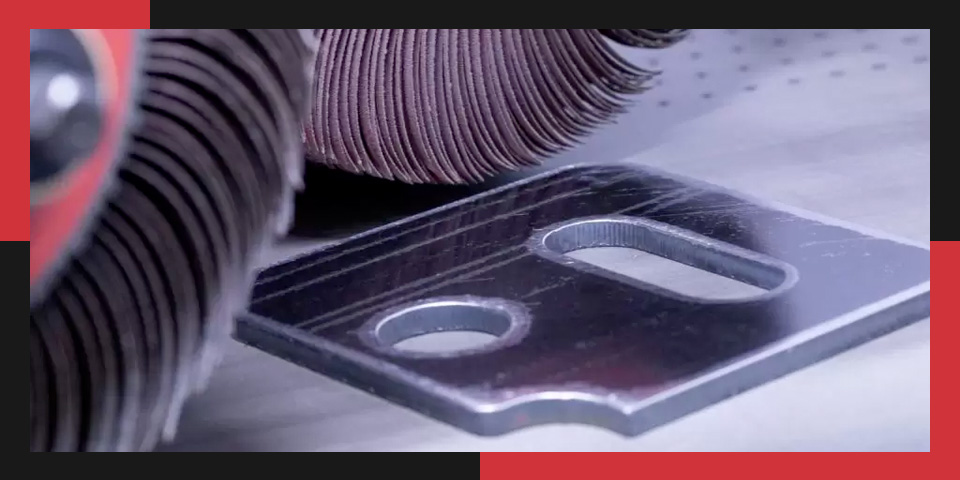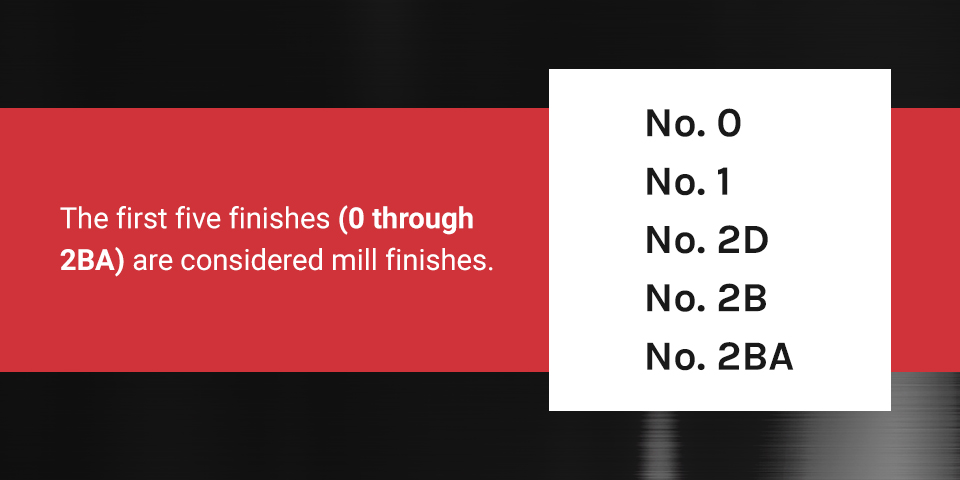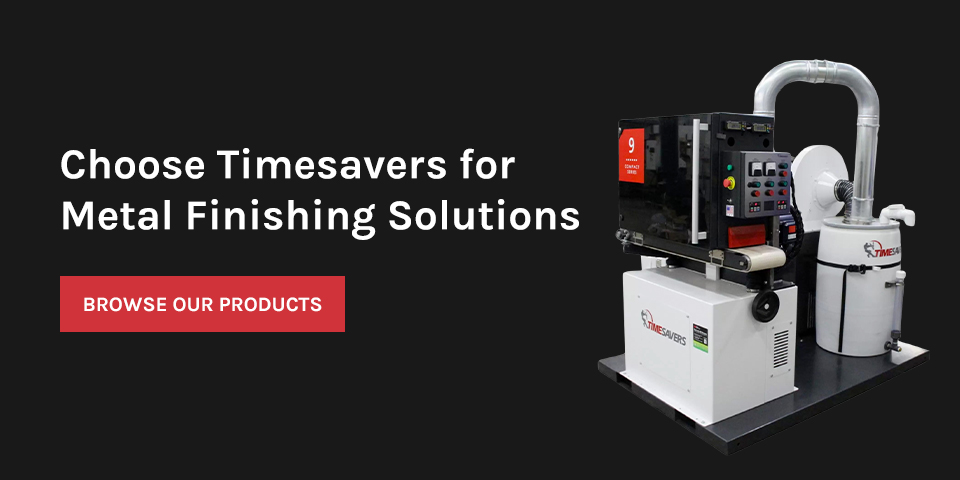Types of Metal Finishes

The processing of metal is incredibly meticulous involving various steps, from cutting and rolling to annealing. You also have various metal finishing techniques to choose from, each suited to different applications. Below, we’ll explore the different metal finishes to help you select the ideal type for your project.
What Is Metal Finishing?
Metal finishing is the final step of the manufacturing fabrication process. It entails various processes that enhance appearance, texture, durability, tarnish resistance and environmental protection. These processes include:
- Cleaning
- Deburring
- Descaling
- Machining
- Polishing
- Edge rounding
- Blasting
- Coating
- Plating
Metal surface finishing also reduces surface roughness for any additional processes, like mating and sealing. The result can range from dull to glossy and bright, depending on the type of finish you choose. Each type of surface finishing process provides unique advantages, which you’ll learn about below.
How to Choose a Metal Finishing Process
Here are some essential considerations when choosing a sheet metal surface finish.
1. Lead Time
Maintaining an efficient supply chain is important to meet manufacturing requirements and consumer demands. For this reason, you’ll want to account for the lead time when choosing a metal finishing, as some processes are more time-consuming than others.
How soon should your product be ready? Does the project have stringent deadlines? Does the finishing process offer the speed required to meet this deadline? These are all key points to consider.
2. Cost-Effectiveness
Some metal finishing manufacturing processes are more costly than others. However, they compensate for the added expense with faster, higher-quality results. Establish your budget for metal finishing and whether a specific finish accommodates those needs.
Will another metal finish provide similar results at a lower price point? Will the process require customized tooling and various set-ups that further add expenses to the manufacturing process? Will the finish offer a worthwhile return on investment? Asking these questions can help you determine which metal finish will be the most cost-effective investment for your business.
3. Metal Hardness
Harder metal components require a more robust, abrasive metal finishing process to ensure reliable performance and an acceptable finish. Consider material properties like hardness, corrosion resistance, tensile strength and malleability when selecting a finishing technique.
How much force is needed to penetrate the metal? How easy is it to solder and cut the material? How hard or pliable is it? These questions can help you pick an appropriate finish for your project’s materials.
Metal Finish Options

There are several types of surface finishes and standard uses. The first five finishes (0 through 2BA) are considered mill finishes. Mill finishes are often used for stainless steel sheet products. You can use them as-is or refine them further through additional steps, depending on your desired appearance.
No. 0
Number 0 finishing is the typical starting point finish for tempered, hot-rolled and annealed metal sheets.
No. 1
A Number 1 finish is created through hot rolling, annealing, pickling the material in acid and passivating, resulting in a dull finish and slightly rough surface. It’s commonly used when a smooth, decorative finish isn’t required, like in elevated temperature applications.
No. 2D
Manufacturers produce Number 2D finishes through cold rolling, annealing, acid pickling and passivating. The outcome is a smooth, dull finish. It’s often used for hardware, roofing, furnace parts, chemical equipment and exhaust parts.
No. 2B
Number 2B finishes are cold-rolled, annealed, pickled and passivated. They involve an additional light temper pass through highly polished rollers. The result is a bright, glossy and slightly reflective finish. It’s often used in cookware and bakeware, pharmaceutical equipment and plumbing fixtures.
No. 2BA
A Bright Annealed Finish (2BA) is cold-rolled, then annealed in a controlled environment to prevent scale buildup. Acid pickling isn’t usually necessary since a thin oxide film is created during annealing.
A 2BA finish uses the same processing as 2B but involves annealing in an oxygen-free vacuum. The result is a mirror-like finish with some slight imperfections. These finishes are frequently used in cookware, surgical instruments and trim appliances.
No. 3 and 4
These finishes are manufactured by polishing a No. 2B finish substrate. They can be created with abrasive cloth belts ranging from grit 120-180 or up to the 240-320 range. Number 3 and 4 finishes are commonly used for stainless steel products, such as:
- Elevator doors
- Escalator trim
- Restaurant and kitchen equipment
- Brewery equipment
- Hospital equipment
- Sinks
- Architectural wall panels
No. 5
A Number 5 finish is applied with a non-woven abrasive. Finishes with non-woven materials or rotary brushes are typically used for metal components only requiring a finish for aesthetic purposes.
No. 6
A Number 6 finish is produced by Tampico-brushing a Number 4 finish. It has a dull, silver-white appearance and is slightly less reflective than Number 4. It was a go-to for stainless steel architecture until the 1980s but is less common today.
No. 7
Number 7 finishes are created by buffing a surface that has been refined to a Number 6 finish. The result is a highly reflective finish with visible grit lines. It’s almost mirror-like. These finishes are suitable for wall panels, column covers and ornamental trim.
No. 8
Number 8 is considered the most reflective of all finishes. It requires the use of an ultra-fine abrasive coupled with the utilization of a lubricant to produce a mirror-like finish. These finishes have many applications, including signs, wall panels and press plates. You might be familiar with Chicago’s famous bean-shaped stainless steel sculpture, which uses a Number 8 finish.
Non-Directional Finish
A non-directional finish involves sanding with abrasive pads with no specific direction of the grain. This random orbital finish is usually applied to metal for escalators and elevators.
Hairline Finish
A hairline finish has long, uniform lines extending along the length of the sheet metal. It’s a common finish for architectural applications.
DUPLO and Microlon Finishes
Created using an abrasive belt and Scotch-Brite brush, DUPLO finishes have short parallel lines extending along the metal’s surface. Similarly, Microlon finishes are applied with Scotch-Brite brushes or belts. These finishes are widely used for:
- Kitchen equipment
- Elevator panels
- Food processing units
- Dairy equipment
- Vehicle components
- Storefronts
Powder Coating Finish
Powder coating finishes are highly corrosion-resistant and visually pleasing. They are ideal for household appliances, bicycle frames, automobiles, drum hardware and aluminum extrusions.
Sandblasting Finish
A sandblasting finish uses fine sand particles directed at the surface of the product at a high velocity, leaving behind a smooth, uniform surface texture. It removes impurities like old paint, rust, grease spots and scale from the metal. Sandblasting also helps bond the primer to the metal, preventing the powder coat from peeling off the metal surface.
Choose Timesavers for Metal Finishing Solutions
A machine tool offers an efficient way to achieve the different finishes listed above. Whatever type of finish you decide, Timesavers’ metal finishing machines can help you bring it to life. Our solutions are designed to increase production speed, eliminate the need for manual labor and yield higher-quality finishes.
Browse our metal finishing products or contact us with questions!

